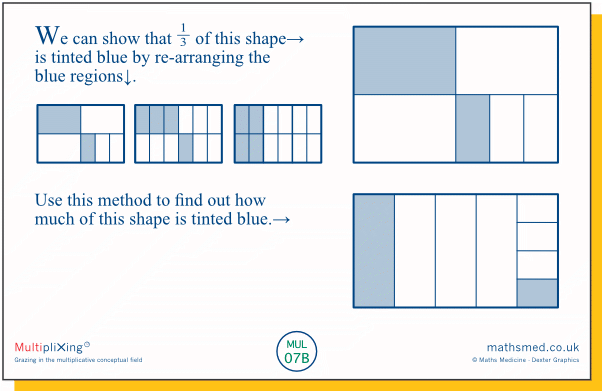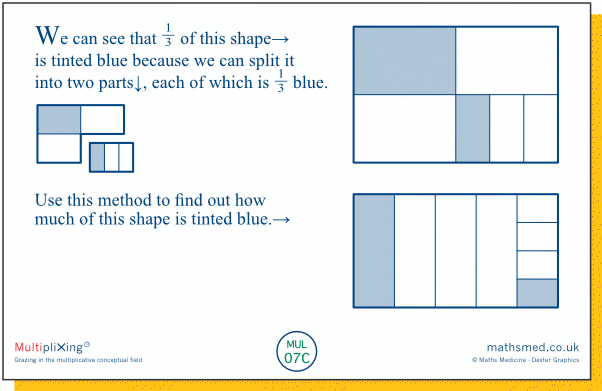[Note: GERMAN versions of the Week 7 tasks are available HERE. I welcome suggestions on how to improve the translations!]
In this week's tasks we tint different parts of a shape in different ways and consider ways of determining what fraction of the whole shape has been tinted. We use fairly simply fractions, or fractions that are related in fairly simple ways.
The tasks provide plenty of scope for adding fractions and for connecting numerical methods to the underlying geometry of the shapes.
It is likely that students will use some fairly standard numerical method to solve the task, by first expressing the tinted area as 1/4 + 1/12, or perhaps even as 3/12 + 1/12 from the outset. Seeing that the smaller tinted region represents 1/12 involves a fairly simple but nonetheless crucial step of actively partitioning the overall shape into 12 equal regions. Similarly, seeing that 3/12 + 1/12, say, is equal to 4/12 and not 4/24 involves some awareness that when adding fractions we don't just add all corresponding parts.
We can split the larger tinted region into 4 equal parts, each the same size as the other tinted region, and then move three of these to complete a tinted row along the bottom of the whole shape and occupying ¼ of the whole shape.
Or we could split the smaller tinted region into 4 identical regions using vertical cuts, and then place these against the right hand edge of the other tinted region - but it could be quite a challenge to show that this newly-formed single region covers ¼ of the whole shape.
Thursday: Here we have a rather strange but intriguing variant on Wednesday's task, where we partition our shape into more and more, smaller and smaller, parts, each of which is ⅓ blue, except for the smallest part. So at each step, ⅓ of the whole shape is tinted blue, except for the ever smaller part that is still untinted.
We can also discern visually that our slanting line of ever-smaller tinted rectangles is matched ever more closely by two slanting lines of ever-smaller untinted rectangles above and below it.
Friday: Here we dispense with tinted shapes and just look at an ever-longer series of fractions. This time the sequence converges on ¼.
They get ever closer to ¹⁄₄ = ⁶⁄₂₄ = ³¹⁄₁₂₄ = ¹⁵⁶⁄₆₂₄.
Students might notice that decimals like 0.333... also belong to this kind of fraction series. The denominators of 0.3, 0.03, 0.003, etc, are multiples of 10, but the series converges to 3/9.






